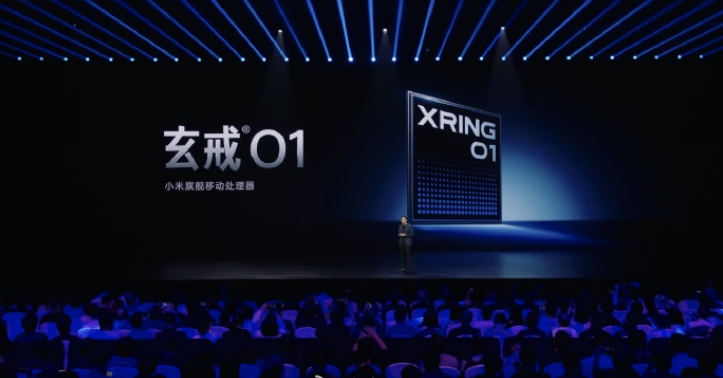Xiaomi's Dual-Front Campaign: Navigating the Challenges of Car Manufacturing and Chip Development
![]() 05/26 2025
05/26 2025
![]() 605
605
2025 marks the 15th anniversary of Xiaomi's founding, a milestone that underscores the company's remarkable progress and ambition.
Last year, Xiaomi made headlines with 88,000 pre-orders for the Xiaomi SU7 within a day of its launch in the new energy vehicle sector. This year, in May, Xiaomi delivered another significant breakthrough in the chip sector with the launch of the Xuanjie O1, which utilizes a second-generation 3nm process and ranks among the top-tier flagship experiences.
In the highly competitive chip industry, the pursuit of the 3nm process threshold has proven challenging. Samsung attempted but fell short with a 20% yield rate, leading to project failure. OPPO's Zeku venture similarly ended after three years of investment. Despite these setbacks, Xiaomi chose to persevere, boldly facing the difficulties and leaving a valuable spark for China's advanced chip process design.

Chip development and car manufacturing are both notoriously difficult endeavors, requiring billions of investments and a decade of validation. Few companies in domestic and international technology history have successfully navigated both challenges simultaneously. Xiaomi, however, has achieved dual breakthroughs in these sectors, showcasing its steady progress towards becoming a "great hard-core technology company" and reflecting Lei Jun's long-term vision.
Just as DeepSeek boosted confidence in China's AI capabilities, Xiaomi's Xuanjie chip aims to demonstrate the strength of China's chip industry to the world, offering a glimpse of attainable progress rather than an insurmountable gap.
Dual Breakthroughs in Car Manufacturing and Chip Development
While the technology industry debates about 'focus' and 'track selection,' Xiaomi has shattered conventional wisdom with its unprecedented dual-front campaign.
In 2021, Xiaomi made two strategic decisions that will shape the company's direction for the next decade: entering the car manufacturing sector and relaunching its chip development efforts.
At last week's conference, the official unveiling of the Xiaomi YU7 garnered significant attention, with the Xuanjie O1 chip becoming the first mainland-developed and designed 3nm flagship chip, bridging the gap in advanced processing capabilities in China. Xiaomi has thus accomplished what Apple failed to achieve in automotive ambitions and surpassed Tesla's self-developed chips.

Behind the impressive Xuanjie O1 lies a decade of evolution for Xiaomi in chip development, from "tragic trial and error" to "extreme breakthrough."
In 2014, Xiaomi embarked on its chip development journey, establishing Pinecone Electronics. The Penta S1 chip, released in 2017, faced challenges due to processing and experience issues, leading to the uncertain future of the Penta S2 and the temporary termination of Xiaomi's chip development efforts.
However, Xiaomi demonstrated strategic resilience, opting for a detour strategy to continue advancing in the chip space, launching ISP image chips like the Penta C1 and fast-charging chips like the Penta P1. These "small chips" honed the team's capabilities in IP module design, energy efficiency optimization, and other key areas.
In 2021, alongside its entry into car manufacturing, Xiaomi restarted its large-chip business and resumed R&D on mobile SoCs. The result is the Xuanjie O1, featuring TSMC's second-generation 3nm process with 19 billion transistors, offering performance and power consumption comparable to Apple's A17 Pro, positioning it at the forefront of the industry.
To appreciate the value of the Xuanjie O1, one must understand the significance of the 3nm process. In the microscopic world of chip manufacturing, the smaller the nanometer number, the stronger the performance. The 3nm process involves cramming 19 billion transistors into a chip the size of a fingernail, nearly 30% more than 5nm.
Beyond the 3nm process, the Xuanjie O1's overall performance is commendable. On the CPU side, Xiaomi deviated from the market's standard eight-core setup, adopting a unique 10-core design with two super-large cores, six large cores, and two high-efficiency small cores, balancing performance and energy consumption. On the GPU side, it employs an ultra-large-scale 16-core setup, ranking among the top in the current era.
Since the May 22 conference, multiple tech bloggers have reviewed Xiaomi's 15 S Pro with the Xuanjie O1 chip. The results show that the Xuanjie O1's experience and power consumption are among the best in the industry, second only to Qualcomm's Snapdragon 8 Ultimate Edition and Apple's A18 Pro, indicating that the market's evaluation of Xiaomi's chips is no longer merely sentimental but based on the chip's merits.
The ultimate performance of a mobile phone is a systematic project, with chip capability being a foundational element. Xiaomi's 15 S Pro achieves deep coordination between hardware architecture and operating system software through the integration of self-developed chips, maximizing performance and minimizing power consumption.
This foundation allows Xiaomi to gradually grasp the characteristics of underlying hardware and achieve software-hardware integration. In Xiaomi's product ecosystem, this integration enhances user experience through differentiated imaging, more efficient energy management, and the underlying unification of future AIoT ecosystems.
From a broader perspective, Xiaomi's ambitions extend beyond chips and car manufacturing. The underlying logic behind its dual-front campaign lies in discovering the "golden intersection" of the smart ecosystem. IoT is a crucial part of Xiaomi's vast ecosystem, and the billions invested in R&D are amortized across mobile phones, automobiles, and IoT devices, reducing the pressure on individual projects compared to competitors focused on a single field. This "R&D flywheel" is a strategic opportunity missed by Tim Cook when abandoning Apple's car project and Elon Musk when outsourcing mobile phone chips.
Walking on Two Legs: The Synergy of Huawei and Xiaomi's Routes
Amid the ongoing restructuring of the global semiconductor industry, Chinese technology enterprises face a challenging balancing act: finding the optimal solution between autonomous controllability and international leadership.
Lessons from Huawei's sanctions and Xiaomi's breakthrough with the Xuanjie chip illustrate that chip design and manufacturing are like two legs of a person, requiring synchronous evolution. Any unilateral breakthrough or lag hinders the building of complete industrial competitiveness. Design capabilities cannot wait for manufacturing maturity, and vice versa.
In simple terms, if the semiconductor industry relies solely on design without manufacturing, it's like building a house on someone else's foundation. Conversely, abandoning design due to manufacturing constraints prevents participation in high-end competition.
Xiaomi's approach proves that in a stage where manufacturing is constrained by others, design capability serves as the "technical anchor" ensuring chip enterprises remain connected. Semiconductors are a globally divided industry, and no country can fully control the entire chain independently. The U.S. relies on TSMC for manufacturing, and Europe's ASML depends on the global supply chain for its lithography machines. Closing off would only exacerbate China's lag.
Xiaomi insists on using TSMC's 3nm process rather than waiting for domestic mature processes, ensuring its chip design capabilities remain connected. Abandoning advanced process R&D due to sanctions would completely forfeit the opportunity to catch up in the future.
China's current chip manufacturing goal is not merely 100% localization but independence in key areas to maintain global competitiveness. Xiaomi and Huawei's routes, while different, are complementary: one ensures China stays at the high-end chip table, while the other builds a bottom-line capability for autonomous controllability.
These two models form a defensive line: Huawei ensures "not being choked," while Xiaomi strives "not to be left behind."
When OPPO's Zeku disbanded and Samsung abandoned self-developed CPU cores, Xiaomi counter-cyclically increased investment in chip design, keeping pace with international advanced processes. In the longer term, Xiaomi's launch of the 3nm Xuanjie O1 in 2025 is crucial in three aspects:
Firstly, it builds a talent pool. 3nm design experience cannot be gained through theory alone but requires practical expertise. Xiaomi's team has become one of the few "talent pools" in China with advanced process design capabilities, nurturing top chip talents.
Secondly, it enhances technological discourse power. Continuous participation in the latest process competition allows for quick adaptation when manufacturing breakthroughs occur, avoiding future passivity.
Thirdly, it strengthens supply chain security. Every additional design player adds to the industry's pursuit of international advanced levels. Alongside pioneers like Huawei, Xiaomi now stands as another flagship bearer for China's chip industry.
Xiaomi's Latecomer Comeback
In the long history of the technology industry, early movers often hold advantages but never block all paths.
ChatGPT by OpenAI was once seen as the ultimate overlord in large models, but China's DeepSeek achieved technological overtaking in just 18 months. Boston Dynamics' robots amazed the world, but Unitree Robotics brought quadruped robots to ordinary laboratories with lower costs and faster iteration speeds. When 3nm chip design capabilities were predominantly in the hands of foreign manufacturers like Apple and Qualcomm, Xiaomi's Xuanjie O1 chip proved that latecomers can find breakthroughs with long-term commitment.

Xiaomi's chip development journey was planned with a 10-year investment of 50 billion yuan, revealing a sober understanding that chip development is a marathon, not a sprint. This approach demonstrates Xiaomi's resilience and determination to become a hard-core technology company.
What sets Xiaomi apart is its ambition from the outset. Its first-generation chip was benchmarked against international advanced processes, with over 13.5 billion yuan invested in three years, setting the goal for its first product to be a "contemporary flagship." While others "practiced" with mature processes, Xiaomi dived directly into 3nm R&D, taking a "high-profile and aggressive" approach. This willingness to face difficulties has propelled Xiaomi from behind.
Looking back from 2025, Xiaomi's 10 billion tuition fee for chip development, DeepSeek's 10,000-card training, and Unitree Robotics' 10,000 falls may be the required courses for China's technology industry to move towards high-end. The birth of great enterprises is not about gambling on trends but resilience through cycles. All miracles are footnotes to long-termism.








